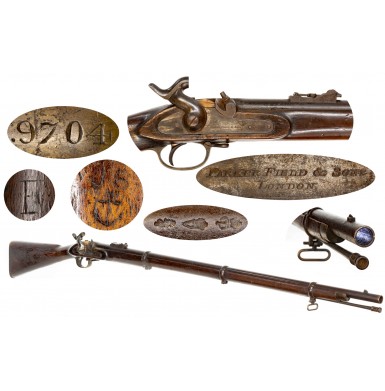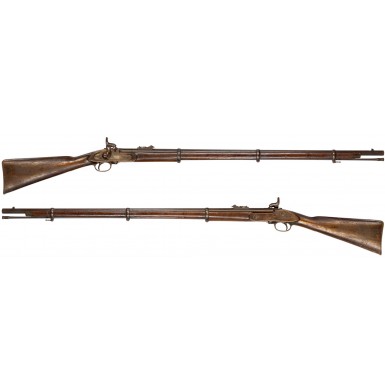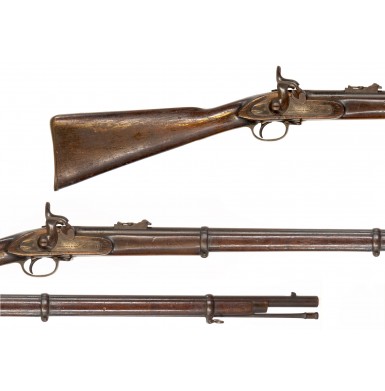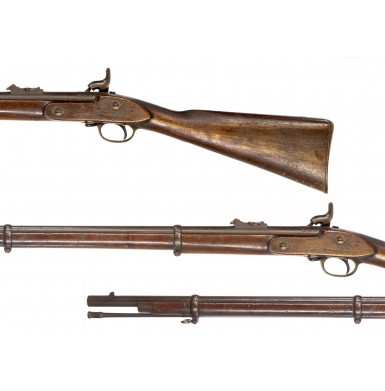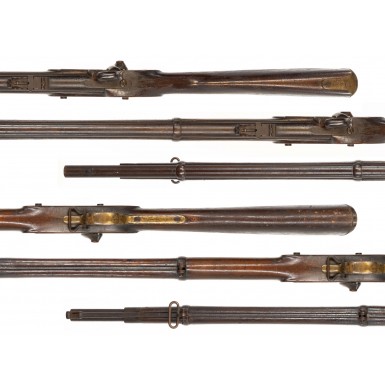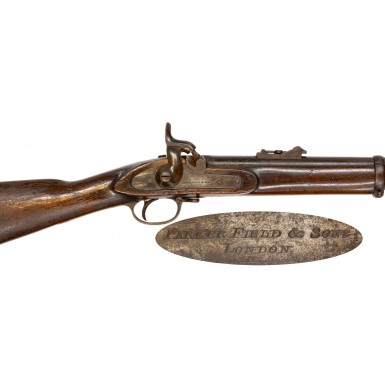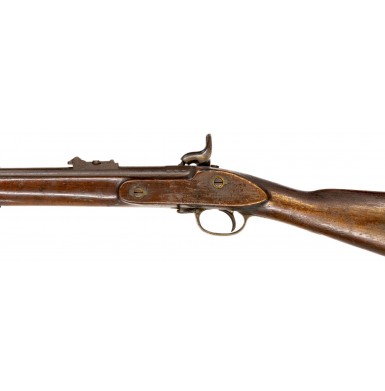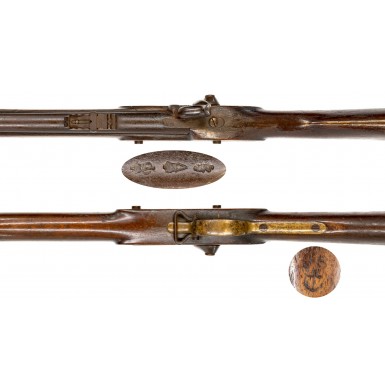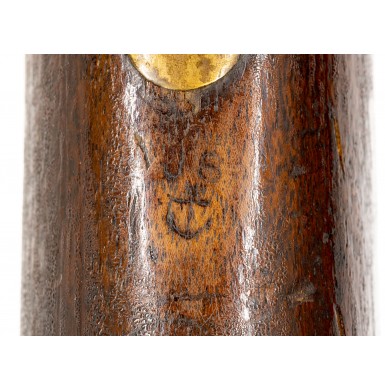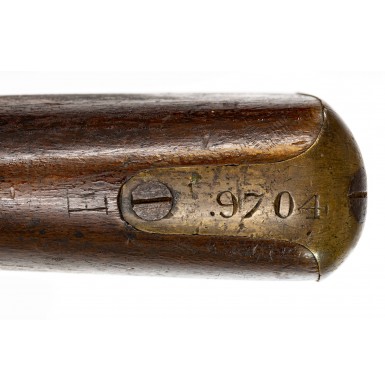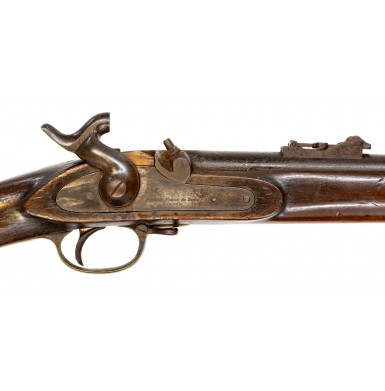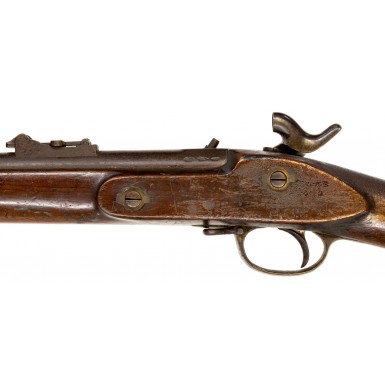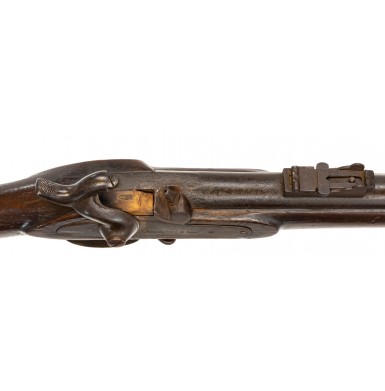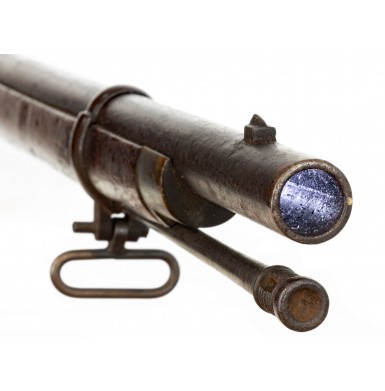Confederate Inventory Numbered JS-Anchor Marked Pattern 1853 Enfield by Parker, Field & Sons
- Product Code: FLA-3985J-SOLD
- Availability: Out Of Stock
-
$6,950.00
The most iconic of the imported arms to see service with the Confederacy during the American Civil War was the British Pattern 1853 Enfield Rifle Musket, marked with the Confederate JS / {ANCHOR} viewer’s mark of John Southgate, combined with an engraved Confederate inventory number on the tang of the brass buttplate. If a collector were to have only one true Confederate imported weapon in their collection, one of these Confederate marked Enfields would be the perfect addition. There is no more striking image than that of the ragged Confederate infantryman with a Pattern 1853 Enfield Rifle Musket in his hands, doggedly defending his belief in states’ rights and defending the boarders of his state from what the average southern soldier perceived as a northern invasion.
During the early days of the American Civil War, Confederate purchasing agents did a splendid job of tying up contracts for the British Pattern 1853 Enfield Rifle Musket, which was truly one of the most advanced and well-made military long arms of the day. According to Confederate Chief of Ordnance Josiah Gorgas’s 3 February 1863 summary of imported arms, some 70,980 “Long Enfield Rifles” had been purchased from the beginning of the war through the end of 1862. These numbers only account for Confederate central government purchases, and do not include those Pattern 1853s purchased by the individual Confederate states or by speculators seeking to sell them within the Confederacy.
The majority of these arms were purchased from the firms of S. Isaac, Campbell & Company (who relied on John Edward Barnett & Sons to deliver many of those arms) or Sinclair, Hamilton & Company, who often routed their sales through S. Isaac, Campbell & Co as well. Additional Pattern 1853 Enfields were purchased from William Grazebrook of Liverpool, who made his first sales to Confederate purchasing agent Caleb Huse within thirty days of the first shots being fired at Fort Sumter. Sinclair, Hamilton & Company entered into several contracts with the Confederacy to deliver Pattern 1853 Enfield Rifle Muskets, with the typical contract terms requiring 30,000 arms to be delivered over a six-month period. During the course of the war, Sinclair, Hamilton & Company appears to have received as many as five of these contracts for Pattern 1853 Enfield Rifle Muskets from the Confederate central government. The second of these contracts for 30,000 Pattern 1853 “Long Enfields” is represented by the guns with the JS / {ANCHOR} mark, along with the engraved buttplate tang inventory numbers. These inventory numbers ran from 1-10,000 in three series. The first series had no suffix after the number, while the second series of 10,000 had an “A” suffix under the inventory number and the third series of 10,000 had a “B” suffix. These numbered guns represent the October 1861 contract with Sinclair, Hamilton & Company that is referred to in Confederate documents as the “Second Contract”. This contract required the 30,000 Enfields to be delivered between October of 1861 and April of 1862. At least two identified “B” suffix guns with three-digit inventory numbers have been determined to have been issued in Corinth, MS immediately prior to the battle of Shiloh on April 6-7 of 1862. Thus, is it clear that the contract timeline for production and delivery was closely followed, and the Confederacy did a good job of transshipping the arms from their Caribbean receiving and storage facilities through the Union blockade to the south during the first year of the war.
Sinclair, Hamilton & Company acquired the arms they sold to the Confederacy through a group of arms makers that were referred to in period documents at the “Five Furnishers”. These were well-established gunmaking firms that were able to fill the large Sinclair, Hamilton & Company orders in a reasonable period of time. The “Five Furnishers” were the long time London gunmakers EP Bond, Parker, Field & Sons, and James Kerr. Kerr apparently received a tiny portion of the contract, only 500 guns, due to his postion with the London Armoury Company where he was the production manager. Archibald Hamilton of Sinclair, Hamilton & Company was the managing director of The London Armoury Company, and James Kerr (of Kerr revolver fame) was London Armoury Company’s manager. The balance of the guns were delivered by the Birmingham based firms of C.W. James and W.C. Scott & Son. The furnishers often marked the guns that were delivered under portion of this contract with a large single letter on the upper comb of the stock, just forward of the buttplate tang. The guns were marked with a B for E.P. Bond, an F for Parker, Field & Sons, a J for C.W. James, a K for James Kerr, and an S for Scott & Son. A sixth single letter mark, P, has been noted on extant Confederate Enfields from this contract. This mark was previously thought to be an alternate mark for Parker, Field & Company. However, more recent examination of extant examples and the other associated marks on those guns has revealed that this was the mark of Francis Preston of Manchester, England. Preston’s relationship within the contracting circle is not clear, but he delivered many socket bayonets for the numbered guns of this contract and may have received a small sub-contract to provide long arms as well. No period documents have shown that Preston delivered the guns directly to Sinclair, Hamilton & Company, so it is most likely that his guns were sub-contracted by James or Scott, who delivered the majority of the guns.
A letter dated 31 October 1861 from Sinclair, Hamilton & Company notes that the contract was divided between the furnishers as follows:
CW James - 10,000
Scott & Son - 8,000
E.P. Bond - 6,000
Parker, Field & Sons - 5,500
James Kerr - 500
This indicates that the guns delivered by CW James (the largest supplier) represented about 33% of the total delivery under this contract, Scott & Sons about 25%, Bond about 20% and Parker, Field & Sons about 18% and the guns from Kerr represented less than 2% of the deliveries. An extensive database comprised of roughly three decades of collected information related to Confederate purchased Enfields contains slightly less than 300 extant examples of 2nd Contract inventory numbered Pattern 1853 Enfield rifle muskets. This number does not count state purchased guns. Of those guns, the large majority are numbered guns with no suffix, representing about 74% of the recorded samples. A-suffix guns represent about 19% of the recorded examples, while B-suffix guns represent about 7% of surviving examples that are recorded. To date, less than 50 A-suffix and less than 20 B-suffix Pattern 1853 Enfields are known to exist. The reason for the paucity of these arms is not clear, but it may simply be the result of attrition and the arms having been used up. With B-suffix guns, which would have theoretically been delivered later than the no suffix or “A” guns, the lack of extant examples may be an indication of the early successes experienced by the Union’s Atlantic Blockading Squadron. Recorded numbers show a good distribution of engraved numbers from two digits through the mid 2XXX range. Then there is then a nearly 4,000 number gap in the database that seems to indicate that a large number of the “B-guns” in the 25XX to 62XX range may well be on the bottom of the Atlantic Ocean. “A suffix” guns, although uncommon and with few examples to study, show a nice even distribution through the entire numbering sequence. This suggests that their scarcity today is the result of them having seen hard use, rather than having been dumped overboard while a Confederate blockade runner tried to elude a pursuing US Naval vessel.
The Pattern 1853 Enfield Rifle Musket offered here is a classic example of a Confederate marked and imported musket from the 2nd Sinclair, Hamilton & Company contract that clearly saw use in the field. The gun is in VERY GOOD+ to NEAR FINE, untouched condition and is crisply marked in the wood behind the trigger guard with the desirable JS / {ANCHOR} mark. The buttplate tang is engraved with the inventory number 9704 indicating that this gun was delivered at the end of the first group of 10,000 muskets to be delivered under the 2nd Sinclair, Hamilton & Company contract. Based upon a study of extant examples, their inventory numbers and the lock dates on the Birmingham made guns, this rifle musket was likely produced in early 1862. The gun bears a very crisp and clear F furnishers mark, indicating that it was delivered by Parker, Field & Sons of London.
The firm of Parker, Field & Sons (also known as Parker, Field & Company) was established as Field & Parker, goldsmiths & gunmakers at 233 High Holborn Street in London around 1792. William Parker took over the firm after Field’s death, and remained at the same location through 1841, with Field’s son John eventually joining the business. During that time the firm also maintained workshops and stores at several other London addresses. In about 1841 the company became known as Parker, Field & Sons, adding John Field (son in law to William Parker) and William Parker’s sons John William Parker Field and William Shakespeare Field to the business, with their sole occupation being gunmaking. The firm continued to use the High Holborn address through 1876, and as before operated additional workshop locations at a variety of London addresses over the next several decades. The firm ceased operations in 1886. During the Civil War, Parker, Field & Sons delivered thousands of Pattern 1853 Enfield rifle muskets to the Confederacy, primarily through Sinclair, Hamilton & Company. They also delivered some of the Enfields for the state of Georgia’s contract, with at least 200 of the Pattern 1856 Sergeant’s Fusils for India Service and 140 Pattern 1853 Enfields being listed on the manifest showing Georgia purchased arms shipped on board the blockade runner Gladiator. A handful of revolvers are also known in the US with Parker, Field & Sons retailer marks, and potential Confederate provenance, but no contracts for the delivery of handguns to the Confederacy by Parker, Field & Sons are known.
As previously noted, this Confederate Enfield is in VERY GOOD+ to NEAR FINE, untouched condition, especially for an early war Confederate purchased and used Enfield. The lock is marked in two lines, forward of the hammer, PARKER FIELD & SONS / LONDON, without the typical British “crown” mark to the rear of the hammer. The gun is a commercial one and bears no British military marks at all, which is typical of guns bound for export markets. The upper left of the breech is marked with the usual London commercial View and Proof marks, with no external gauge mark. On most London commercially proved guns, the gauge mark is found under the barrel. The interior of the lock is clearly marked FIELD over the mainspring, along with the initials I.D. and J.P., which are probably the marks of the lock maker and the “setter up” who was the workman who assembled the gun. The bottom edge of the lock bears the file slash mating mark \ \ \/ | |. The bottom of the barrel is marked with the name of the barrel maker, EZRA MILLWARS as well as with the initials J.F. who was probably another workman involved in the manufacture of the barrel. The bottom of the barrel is additionally marked FIELD, and with the gauge mark 25 (indicating .577 caliber). The barrel is also marked 27which is probably a workman’s Arabic numeral interpretation of the \ \ \/ | | mating marks that are fond throughout the balance of the gun. This same mating mark is found on both lock mounting screws, the breech plug tang screw, in the ramrod channel of the stock and on the right rear edges of all three of the barrel bands.
The barrel of the gun has a thickly oxidized dark brown patina on the expose surfaces that is untouched and uncleaned. The portions of the barrel that were protected by the barrel bands retains some nice original thinning blue and the bottom of the barrel that has been protected by the stock retains about 80% of the original blue, which is thinning and dulling. The exposed metal surfaces show some moderate roughness and pitting in the breech and bolster area, with evenly distributed light surface roughness and pinpricking over the balance of the barrel. The bore of the musket is in about VERY GOOD+ condition. The bore of the gun is partly bright, and it retains very strong three-groove, progressive depth rifling. The bore shows some evenly distributed oxidation and light pitting along its entire length, with some areas of more moderate pitting present as well. The barrel bands the same untouched deep brown patina as the barrel of the gun. The middle and lower bands retain their “doughnut” shaped keepers on their tension screws, with the one for the upper band’s tension screw is missing. The action of the gun is mechanically very good and functions well on all positions. The lock has a moderately oxidized brownish patina over a dull base color. Part of the lock has been lightly cleaned at some point in the past to make the markings easier to read. However, the lock markings are quite crisp and fully legible, and this cleaning was probably unnecessary. The rear of the lock plate shows some odd scarring that may be from impact or other wear related to service and use. The brass furniture has a nice, untouched, dark umber patina, which is very attractive. The Confederate inventory number 9704 is neatly engraved on the tang. The long-range rear sight is complete and fully functional. The ladder has the same dark brown patina of the barrel bands, while the sight base matches the metal of the barrel. The original combination front sight and bayonet lug is present near the muzzle of the musket. Both sling swivels are present, although the upper swivel appears to be a replacement and not the original swivel from the period of use. However, the rear swivel appears to be original to the. The three original Palmer pattern clamping barrel bands are all in place on the musket and are mating marked to it as mentioned. The original ramrod, which was numbered to the gun, is missing in action. This is typical with numbered Enfields, as less than 10% of extant examples retain a numbered ramrod, let alone the original matching one. The ramrod that now accompanies the gun is an original, Pattern 1853 ramrod from the period, which is full-length and retains fine original threads at the end. The patina of the rod matches the balance of the metal perfectly and it is almost certainly a period replacement from the time of use. Thousands of replacement ramrods were imported thought the Confederate port of Wilmington, NC between 1863 and 1864, suggesting that the breakage and loss of rammers in the field was a constant problem. The stock of the gun is in about FINE condition overall. The stock retains very strong edges and sharp lines and does not appear to have been sanded at any time. The stock is solid, complete, and full-length, with no breaks or repairs noted. The stock has deep, dark, and uncleaned patina that matches the metal of the barrel well. An old coating varnish was applied to the stock very long time ago and this has darkened and alligatored, adding to the patina of the piece and probably helping to protect the stock and its markings. The stock bears the expected JS / {ANCHOR} inspection mark in the wood behind the triggerguard. The JS / {ANCHOR} mark is quite legible and clear, but also shows good age and light wear. The wood has been lightly cleaned in this area at some point in time to make this mark easier to see. As would be expected, the stock does show a wide assortment of scattered bumps, dings and minor mars from service, handling, and storage over the last 150+ years. There is also some moderate burn out and associated wood loss between the hammer and the breech plug tang, behind the bolster. This is a common condition for any percussion long arm that saw heavy use and repeated firing. There is also a small chip of wood missing from the revere of the butt, near the buttplate. All of the wood wear is commensurate with the condition of the gun overall and does not indicate any exceptional wear or any abuse, just lots of honest use.
Overall, this is a great looking, essentially untouched example of a completely authentic Confederate imported and used Enfield Rifle Musket that surely saw field service. The gun has the most desirable and well known of Confederate import marks, a crisp and clear JS / {ANCHOR}. It also has a wonderful, engraved inventory number on the brass buttplate along with a crisp furnisher’s mark on the stock. This gun was clearly a very early arrival in the Confederacy that was likely on the field well before the beginning of the 1862 spring and summer campaign seasons. The erosive percussion cap flash around the breech and the burn out on the stock clearly shows that this gun saw some significant service and fought for Southern independence during the course of the war. Somehow, through all of that use and potential for combat damage, the gun managed to survive in extremely nice and relatively complete original condition. With less than 25% of the numbered Confederate Enfields being delivered by Parker, Field & Sons and with less than 1% of those 30,000 guns having survived to be in collections today, this is simply an incredibly scarce example of a Confederate purchased gun. If you have ever wanted to own a completely authentic, correct, and honest Confederate imported and used Pattern 1853 Enfield Rifle Musket, that really saw service and fought the war, this would be an outstanding addition to you collection. These inventory numbered, Confederate purchased guns are really iconic pieces of history, which were no doubt witness to some of the most horrific moments in the American Civil War. This gun is every bit as Confederate as any Richmond-made rifle musket, and at a much more reasonable in price.
SOLD
Tags: Confederate, Inventory, Numbered, JS-Anchor, Marked, Pattern, 1853, Enfield, by, Parker, Field, and, Sons

